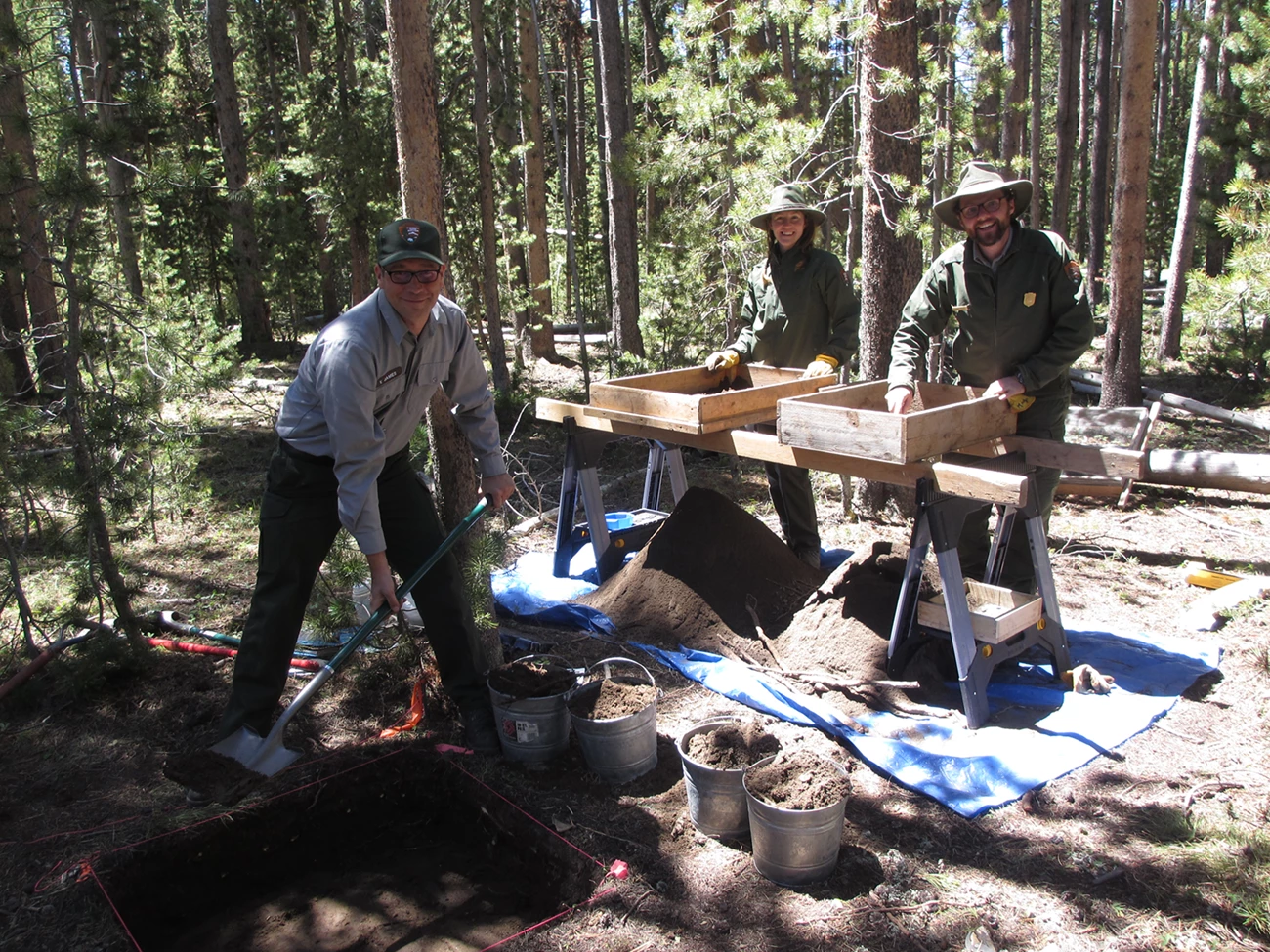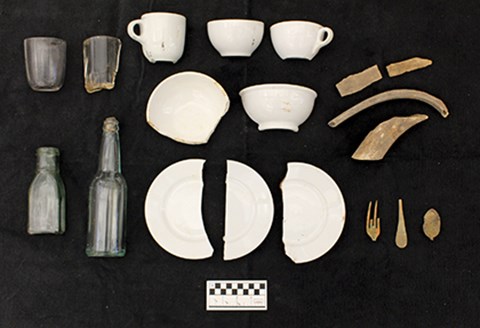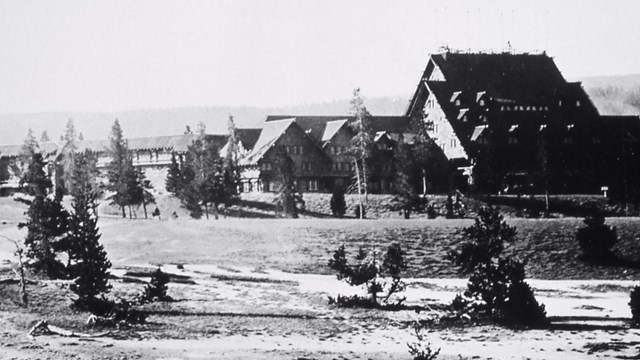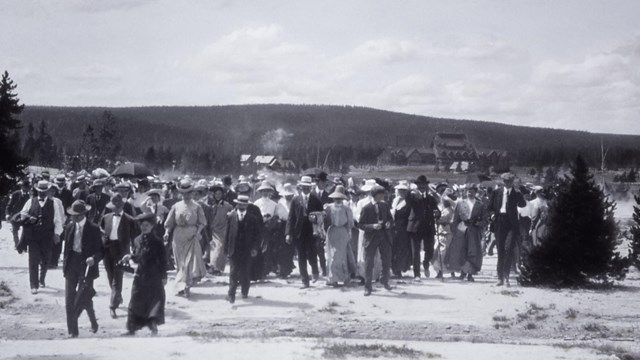
NPS Archeological resources are a key source of information about humans in Yellowstone for nearly the entire time that people have been in the area. Archeological evidence indicates that people began traveling through and using the area that was to become Yellowstone National Park more than 11,000 years ago. Because the intensity of use varies through time as environmental conditions shift, archeological resources also provide a means for interdisciplinary investigations of past climate and biotic change. Many thermal areas contain evidence that early people camped there. At Obsidian Cliff, a National Historic Landmark, volcanic glass was quarried for the manufacture of tools and ceremonial artifacts that entered a trading network extending from western Canada to the Midwest. (Obsidian from different lava flows can be distinguished from one another other using X-ray fluorescence analysis [XRF].) These remnants of past cultures must be preserved, as they are invaluable in our understanding of early people in the area. Historic archeological sites in Yellowstone reveal Native American activities, early tourist camps and hotels, and events of the 1877 Flight of the Nez Perce, as well as US Army activities. Findings in YellowstoneAlthough more than 2,000 archeological sites have been documented since the archeology program began in 1995, less than 3% of the park has been inventoried. Most known sites are located in developed areas because archeological resources have been identified as part of National Historic Preservation Act compliance research related to construction, hazard fuel reduction, or other projects. Multiple prehistoric sites throughout the park are eligible for listing on the National Register of Historic Places. Condition assessments performed on most of the documented sites found 1,109 were in good condition, 467 are fair, 209 are in poor condition, and 250 lack condition data. Twenty-four of the sites no longer exist because of two sites being combined into one, natural erosion, damage from the historic 2022 flood, or disturbance as a result of construction or other authorized activity. Excavations have been conducted at some sites where archeological remains are especially vulnerable to disturbance or loss through erosion or illegal collecting. Prehistoric sites contain projectile points, knives, scrapers, abraders, and other tools, and concentrations of burned and butchered animal bone. Radiocarbon dating is used to establish the age of organic artifacts such as charcoal or bone. Organic materials (wood, bone, basketry, textiles) rarely persist in the Yellowstone environment because of the acidic, thermally influenced soils. However, ice patches in the park can and do preserve fragile organic artifacts. These perishable artifacts complement the oral histories of indigenous peoples as well as an archaeological record of abundant stone tools and manufacturing debris. Stone artifacts provide most of the chronological information on Yellowstone’s prehistory. Most of the stone tools are associated with a particular time period based on distinctive stylistic characteristics, which define a point type. These include some knives, such as Cody knives, or projectile points, such as spear and dart points, as well as arrowheads. At several locations in the park, campsites from distinct periods of indigenous use spanning more than 9,600 years are layered upon each other starting at five feet below the surface. These occupations reveal how tool manufacture and lifeways changed in this region through time. The earliest evidence of humans in Yellowstone are two 11,500 to 10,900-year-old Clovis-type spear points found near Yellowstone Lake and north near the Yellowstone River. Later, projectile point types increase, both in number and the variety of types (style), which may indicate an increase in the number and diversity of peoples using the area. Most documented sites in the park date to the Archaic period (8,000–1,500 years ago), suggesting that may have been the most intense period of use by pre-park peoples. Recent archeological surveys have identified a large number of sites dating to later periods in prehistory (approximately 1400–1800 CE). Distinguishing use of these sites by different ethnic groups or specific tribes, however, has not yet been possible. Assessing Wildland Fire ImpactsArcheological resources can inform us about paleoclimate, paleoenvironment, and the human response to climate change over the past 11,500 years. Long-term climate data suggest current temperature rise and precipitation contribute to longer annual droughts and shorter wet seasons. Given changing environmental conditions, in 2016 the park embarked on a ten-year project to assess wildfire impacts on archeological resources, including those impacted by the historic 2016 Maple Fire and Tatanka Fire Complex. Data indicate sites subjected to intense heat and loss of vegetation are more susceptible to post-fire erosion, flooding, and other landscape processes which expose or threaten archeological resources. Obsidian Sourcing StudiesArcheologists have completed intensive inventories across several river valleys that served as transportation corridors for many pre-park peoples. Newly identified sites include prehistoric quarries, campsites, and lithic scatters dating to between 11,500 and 300 years ago, as well as historical period quarries, campsites, and refuse dumps. These prehistoric sites are increasing our understanding of how early humans procured and used obsidian across the park. Most sites in the northern portion of the park show a heavy reliance on Obsidian Cliff materials and chert, a cryptocrystalline sedimentary rock. Materials from smaller obsidian sources in the park were locally used, supplementing the Obsidian Cliff toolstone. However, along the Lewis and Snake rivers a more diverse range of materials was used. Obsidian was primarily locally sourced from nearby Warm Spring, Teton Pass, and Park Point quarries, while orthoquartzite, a classic sedimentary rock, was the most common material used for manufacturing tools. 
Tourism in YellowstoneThe majority of historical archeological sites in the park are associated with tourism in some manner. Examining these types of sites help us trace the park’s history. Tourism is directly connected to larger social and economic changes occurring across America, including widespread settlement of the American West, and the increasing shift towards a globally integrated economy. Refuse dumps, also known as trash middens, are important sources of information, as they contain a variety of artifacts which provide insight into people living and working in the park. In 2019, archeological fieldwork near Lake Lodge revealed over 450 artifacts dating to the late nineteenth/early twentieth century associated with meals, such as ceramic tableware, utensils, drinking glasses beverage bottles, and butchered animal bone. The various types and qualities of goods, reflected through artifact collections, grant us a unique view of leisure and tourism development in Yellowstone over the past 140 years, a viewpoint that is unavailable in most other places in North America. Archeology-related ArticlesSource: NPS DataStore Collection 7824 (results presented are a subset). To search for additional information, visit the NPS DataStore. 
Tribal Affairs & Partnerships
Yellowstone is the traditional shared homelands of many Tribal Nations whose traditions have shaped the landscape through generations. 
Cultural Landscapes
Yellowstone contains an array of landscapes that reflect the park’s history and development patterns. 
Preserving Cultural Resources
Learn how Yellowstone National Park works to preserve and interpret the human history of the region. 
History & Culture
Explore the rich human and ecological stories that continue to unfold. |
Last updated: April 18, 2025
